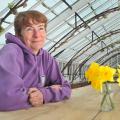AT the end of last year, I was at an RHS gardeners’ networking day down at Hyde Hall, their garden in Essex. They built a winter garden about four years ago and so it was a chance to see how it had developed and learn from the people who designed and built it.
Winter is the season of short, dark days and long nights, and a lack of vibrant colour. But there is a huge array of more subtle colours that add hugely to our enjoyment of our gardens.
At the moment we close at the end of October and although we are here every day working in the garden (weather permitting: it’s throwing it down as I write), we don’t open to visitors.
Long-term we want to be open all year round, but quite a bit needs to be done before we can get there, both in terms of buildings and the garden.
So, off June and I went to Hyde Hall. It was inspirational to hear about how the space had been planned, what had been planted and then to go outside and see the space itself. It helped enormously that it was the most delightful day, clear blue skies and (even more unusual for November just gone) warm sunshine. I was able to cast a clout or two that day.
June told me that when she was training as a garden designer one of her tutors told her “plan for winter and summer will look after itself.”
I hadn’t thought about this before, but when I thought of it, it’s obvious. If you plan the structure of the garden for winter then summer simply develops around it.
This means thinking in terms of shrubs and trees, bark colour and texture, twig and stem colours, catkins, skeletal forms, berries and seed heads.
So, for example, prunus serrula (Tibetan cherry) has fantastic deep cherry-coloured bark which also peels leaving even brighter colour beneath. Salix has bright yellow or orange stems.
I discovered that there are about 50 cornus species which come in shades of red, burgundy, black, salmon pink, green, lemon and orange. Or you could, like Anglesey Abbey (and indeed us) plant silver birches with ghostly white bark for a real stand out display.
We have cornus sericea “flaviramea” with its bright olivey green stems right in front for dramatic contrast.
Architecture planned, then add bulb and herbaceous so that the planting flows from one season to the next.
Winter aconites are little globes of bright orange flowering from January onwards; crocuses flower from autumn (colchicum autumnale) through to spring (crocus tommasinianus and C. speciosum among others).
And, of course, who could have a garden without snowdrops. There are so many to choose from this hardy little gem.
Ted Hughes wrote about them having a “pale head heavy as metal” emphasising how tough they are to flower when they do.
Honestly I could go on but I am running out of space. I haven’t even talked about scent or herbaceous planting. I think I might have to continue this next month.
What I will say is if you are anywhere near RHS Hyde Hall or National Trust property Anglesey Abbey do explore their winter gardens. I struggle with the really short days of winter and the lack of light and I’m sure I’m not alone.
So the more we can make of the colour available in winter the more we can delight in our gardens, even if only looking out of the window while we toast out toes in front of the fire. Enjoy your garden.






Comments: Our rules
We want our comments to be a lively and valuable part of our community - a place where readers can debate and engage with the most important local issues. The ability to comment on our stories is a privilege, not a right, however, and that privilege may be withdrawn if it is abused or misused.
Please report any comments that break our rules.
Read the rules here